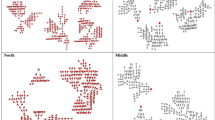Abstract
We mapped hot spots and estimated the numbers of people who use drugs (PWUD) and who inject drugs (PWID) in 12 regions of Tanzania. Primary (ie, current and past PWUD) and secondary (eg, police, service providers) key informants identified potential hot spots, which we visited to verify and count the number of PWUD and PWID present. Adjustments to counts and extrapolation to regional estimates were done by local experts through iterative rounds of discussion. Drug use, specifically cocaine and heroin, occurred in all regions. Tanga had the largest numbers of PWUD and PWID (5190 and 540, respectively), followed by Mwanza (3300 and 300, respectively). Findings highlight the need to strengthen awareness of drug use and develop prevention and harm reduction programs with broader reach in Tanzania. This exercise provides a foundation for understanding the extent and locations of drug use, a baseline for future size estimations, and a sampling frame for future research.

Similar content being viewed by others
References
Bouscaillou J, Evanno J, Proute M, et al. Prevalence and risk factors associated with HIV and tuberculosis in people who use drugs in Abidjan, Ivory Coast. Int J Drug Policy. 2016;30:116–23.
United Nations Office on Drugs and Crime. World Drug Report 2015 (United Nations publication, sales number E.15.XI.6).
Tanzania Commission for AIDS (TACAIDS), Zanzibar AIDS Commission (ZAC), National Bureau of Statistics (NBS), Office of the Chief Government Statistician (OCGS), ICF International. Tanzania HIV/AIDS and Malaria Indicator Survey 2011–12. Dar es Salaam, Tanzania: TACAIDS, ZAC, NBS, OCGS, ICF International; 2013.
National AIDS Control Programme, Muhimbili University of Health and Allied Sciences. Integrated Bio-Behavioural Survey among People Who Inject Drugs in Dar es Salaam; 2014.
McCurdy SA, Ross MW, Kilonzo GP, Leshabari MT, Williams ML. HIV/AIDS and injection drug use in the neighborhoods of Dar es Salaam, Tanzania. Drug Alcohol Depend. 2006;82(suppl 1):S23–7.
Zanzibar AIDS Control Programme. Integrated behavioral and biological surveillance survey among most at risk populations in Zanzibar, 2011-2012. Ministry of Health: Dar es Salaam; 2013.
Emmanuel F, Blanchard J, Zaheer HA, Reza T. Holte-McKenzie M for the HASP team. The HIV/AIDS Surveillance Project mapping approach: an innovative approach for mapping and size estimation for groups at a higher risk of HIV in Pakistan. AIDS. 2010;24(suppl 2):S77–84.
Mathers BM, Degenhardt L, Phillips B, et al. Global epidemiology of injecting drug use and HIV among people who inject drugs: a systematic review. Lancet. 2008;372(9651):1733–45.
Aceijas C, Stimson GV, Hickman M. Rhodes T for the United Nations Reference Group on HIV/AIDS Prevention and Care among IDU in Developing and Transitional Countries. Global overview of injecting drug use and HIV infection among injecting drug users. AIDS. 2004;18(17):2295–303.
United Nations Office on Drugs and Crime. World Drug Report 2014 (United Nations publication, sales number E.14.XI.7).
Zanzibar AIDS Control Programme, Ministry of Health. Integrated behavioral and biological surveillance survey among key populations at risk in Zanzibar, 2011-2012. Zanzibar AIDS Control Programme; 2013.
United Nations Office on Drugs and Crime. International standards for drug use prevention. Vienna: United Nations Office on Drugs and Crime; 2013.
Funding
This research was supported by the Centers for Disease Control and Prevention (CDC) [#U2 GPS 001472].
Author information
Authors and Affiliations
Corresponding author
Ethics declarations
Conflict of interest
The authors declare no conflicts of interest.
Ethical Approval
All procedures performed in studies involving human participants were in accordance with the ethical standards of the institutional and/or national research committee and with the 1964 Helsinki declaration and its later amendments or comparable ethical standards. The protocol was reviewed and approved by the National Institute for Medical Research in Tanzania, the Centers for Disease Control and Prevention (CDC), and the Institutional Review Board of the University of California, San Francisco.
Informed Consent
Informed consent was obtained from all individual participants included in the study.
Rights and permissions
About this article
Cite this article
Ndayongeje, J., Msami, A., Laurent, Y.I. et al. Illicit Drug Users in the Tanzanian Hinterland: Population Size Estimation Through Key Informant-Driven Hot Spot Mapping. AIDS Behav 22 (Suppl 1), 4–9 (2018). https://doi.org/10.1007/s10461-018-2057-x
Published:
Issue Date:
DOI: https://doi.org/10.1007/s10461-018-2057-x




